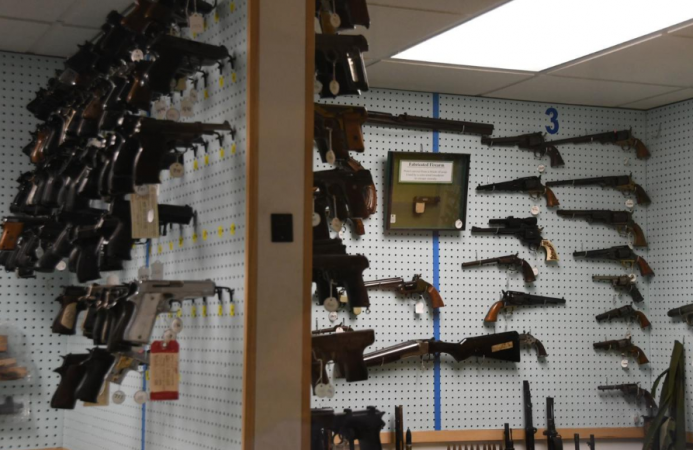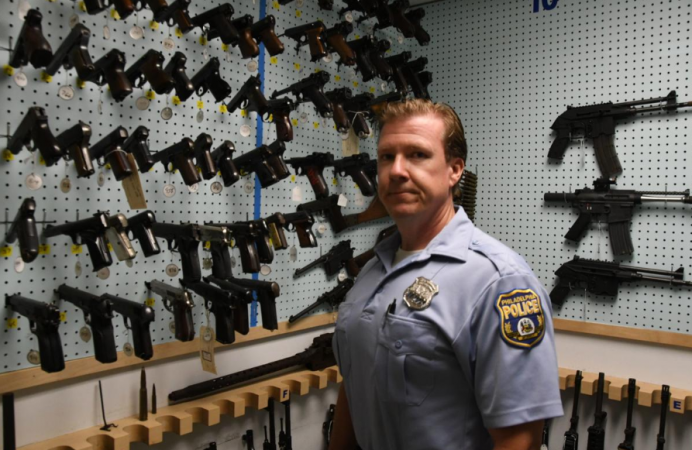A look inside Philadelphia police’s gun archive
Located at the corner of 8th and Poplar streets, the Forensic Science Center is the destination for nearly all criminal guns, weapons, drugs and other evidence collected.
-

Philadelphia Police Officer Bob Mahan holds a firearm stored in the department's Forensic Science Center beside Michael Garvey, director of the Philadelphia Police Department's Office of Forensic Science (Abdul Sulayman/The Philadelphia Tribune)
-

A view inside the gun archive room in the basement of the Philadelphia Police Department's Forensic Science Center (Abdul Sulayman/The Philadelphia Tribune)
-

Inactive grenades hang on the wall in the gun archive in the Philadelphia Police Department's Forensic Science Center. (Abdul Sulayman/The Philadelphia Tribune)
-

Michael Garvey, director of the Philadelphia Police Department's Office of Forensic Science stands inside an evidence room inside the department's Forensic Science Center in June (Abdul Sulayman/The Philadelphia Tribune)
-

Firearms line the walls of the gun archive room in the basement of the Philadelphia Police Department's Forensic Science Center (Abdul Sulayman/The Philadelphia Tribune)
-

This file photo shows the gun archive in the Philadelphia Police Department's Forensic Science Center office, which holds hundreds of firearms of all types and caliber sizes. (Abdul Sulayman/The Philadelphia Tribune)
-

Philadelphia Police Officer Bob Mahan stands in the gun storage room. (Abdul Sulayman/The Philadelphia Tribune)
This article originally appeared on The Philadelphia Tribune.
—
Michael Garvey reached up and pulled down a six-shot revolver hanging on a wall among hundreds of other guns.
He pointed out the diamond lodged in the front sight of the short-nosed 2-inch pistol. That is how you know it was the firearm of choice for a 1980s Philadelphia street gang, said Garvey, the director of the Philadelphia Police Department’s Office of Forensic Science.
“It gets back to this idea of a culture of crime guns,” he said. “The trademark was the gun they were carrying.”
Garvey spoke while standing inside the office’s gun archive, surrounded by firearms of all types and sizes — handguns, AK-47s, Uzis, shotguns — and grenades.
Located at the corner of 8th and Poplar streets, the Forensic Science Center is the destination for nearly all criminal guns, weapons, drugs and other evidence collected by city police every day. Garvey oversees the office’s 13 units and approximately 225 staff members.
Philadelphia police have counted 176 homicides so far this year as of Monday — 5% more than the same date last year. The homicide rate in the city reached a 10-year high last year, and 81% of the victims were black.
Last year, 1,403 people were shot in Philadelphia, of whom 85% were black men, according to data from the police department.
By May, Philadelphia police had collected operable 1,980 guns, according to data from the police department received through a Right to Know request. The city recovered 3,662 guns in 2018; 3,700 in 2017; and 3,868 in 2016, Garvey said.
Philadelphia appears to have an affinity with firearms, said George Mosee Jr., a former prosecutor in the Philadelphia District Attorney’s Office and current executive director of the Philadelphia Anti-Drug/Anti-Violence Network. People believe they instantly grant respect, protection, status and power on the owner.
“That’s why you’ll see so many young people on Instagram or Facebook posing with firearms,” he said. “Just to look tough, to have that reputation.”
And that gun culture is “without a doubt impacting people’s lives every day — the amount of guns we have, the amount of drugs we have,” Garvey said.
Mosee said the level of gun violence in the city creates a cycle where people arm themselves for protection which then increases the likelihood a firearm will be used.
“Statistics bear out that if you carry a gun, you’re more likely to get shot,” he said.
Mosee said younger people getting their hands on guns and homicides occurring today appear to be more random.
“It just feels like there are a lot more accidental killings where this person wasn’t the target, where a corner gets sprayed,” he said. “And I think that may be a result of people, who really don’t have any appreciation for the sanctity of life, are in possession of firearms, weapons that can actually take a life.”
Where do the guns come from?
The vast majority of guns used in crimes in Philadelphia and recovered by the police were originally purchased legally, Garvey said in a follow-up email.
Approximately 80% of the recovered crime guns can be traced back to a legal gun sale in the state, although Garvey did not have data on how many of the original purchasers were the ones using the firearms during a crime.
The majority of the remaining firearms are traced to legal purchases in other states, Garvey said, noting that the recovery of untraceable guns — those with serial numbers removed — are rare.
What do police do with the guns?
When firearms and other evidence, such as fired cartridge cases, arrive at the Office of Forensic Science, officers catalog them, enter them into a database and give them a barcode to track them, Garvey said.
Officers in the Firearms Identification Unit typically examine each gun within 48 hours, which includes test firing the weapon.
The officers then enter the data into the National Integrated Ballistic Information Network, which the U.S. Bureau of Alcohol, Tobacco, Firearms and Explosives manages, to find any similar matches already in the system.
“This process allows the PPD to more quickly identify related shootings or shooting trends,” Garvey said.
Police store the firearms in gun evidence rooms in the basement of the office. In one room, hundreds of manila envelopes containing firearms, gun casings and other evidence found at crime scenes are stored on multiple double-sided shelves.
The city eventually destroys the vast majority of the guns it recovers and does not sell them, Garvey said. The city melts down between 3,000 to 6,000 firearms annually.
“We’re just not going to try to make a profit off on the crime gun, selling them and putting them back on the streets,” Garvey said. “So, once [a firearm is] off of the street, it stays off of the street.”
In the gun archive room, the office maintains at least one model of each type of gun recovered on city streets. Firearm experts use the guns to test against similar style firearms recovered on the streets.
“That way, we’re always learning,” Garvey said.
Philadelphia’s gun culture
Garvey, a Philadelphia native, worked for the Central Intelligence Agency and the Federal Bureau of Investigation before he took over the Office of Forensic Science in 2011. The number of guns plaguing Philadelphia was worse than the other troubled areas around the globe where he has worked throughout his career, he said.
The office’s gun archive tells the story of Philadelphia’s history with guns.
“Every time you look in this room, and every time we look in those other [evidence] rooms, and we see thousands of guns and tens of thousands of cartridge cases, what we’re talking about are crime guns that are being used to terrorize people who live here,” Garvey said.
Similar to most urban areas, handguns are the most common firearm used for crimes in Philadelphia because they are easily concealed.
Before the 1990s, revolvers were the firearm of choice, Garvey said.
Although law enforcement rarely finds glaring symbols and adornments on the firearms anymore, like diamonds lodged into gun sights, police occasionally encounter crews carrying the same make and model firearm, Garvey said. Semi-automatic handguns, such as 9 mm handguns, have become the go-to firearms.
Garvey said a more recent firearm trend that has yet to appear in Philadelphia were handguns and long guns being sold in bright colors, similar to colors associated with fake guns.
Garvey said among the most troubling items in the archive was the wall of BB guns, airsoft guns, water guns and other imitation firearms.
“That person is not going to kill someone else,” he said, “But the odds of them being killed just went up, too.”
mdonofrio@phillytrib.com (215) 893-5782
WHYY is your source for fact-based, in-depth journalism and information. As a nonprofit organization, we rely on financial support from readers like you. Please give today.



